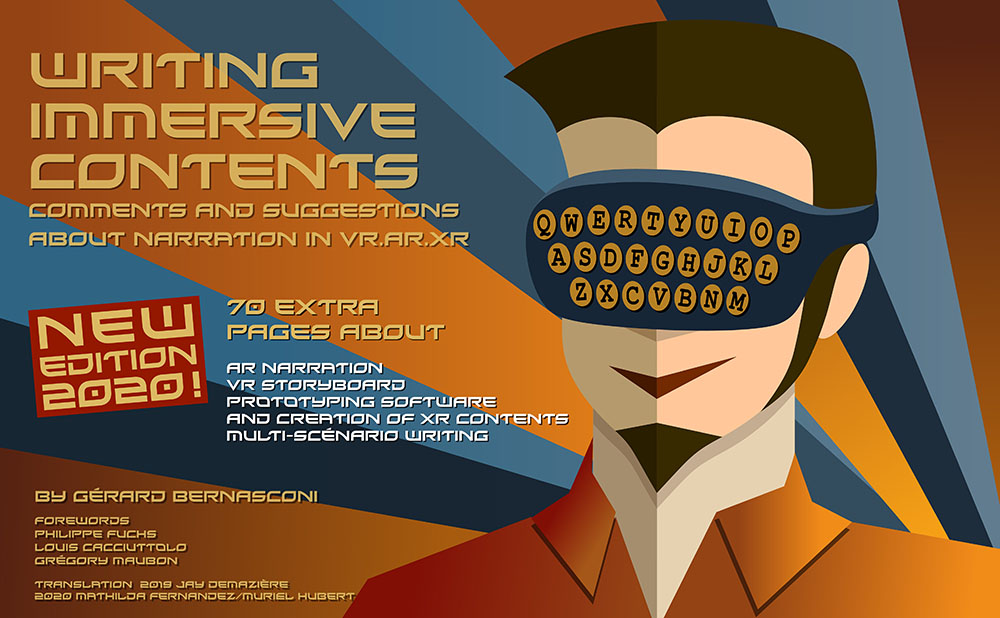
Storytelling is a big part of virtual reality experiences.
Crédits photos : Tima Miroshnichenko (Pexels)
Gérard Bernasconi, writer and director of interactive fictions in virtual reality, wrote an eBook “Writing immersive contents” in which he explains how to write contents for immersive technologies. The eBook, released in 2019, was republished and expanded this year, and will benefit from new contents next year. We discussed with the author of this eBook that talks about writing immersive contents.
What led you to write this eBook “Writing immersive contents”?
Writing for a content in virtual or augmented reality is about reinventing a language, adapt to a support and to the technology and… creating! It is “technological” advances that have changed the world of creation. With each invention of new tools, some have chosen to adapt to create a universal language, others have remained stuck in their habits.
This is why, after many meetings and discussions with professionals, I was convinced that the adaptation to virtual and augmented media had not been deepened. Moreover, in 2018 when I started writing the first edition of my eBook, the VR/AR language was not at all clear. So I decided to work like an artist-researcher-essayist and to apply a narrative solution to each constraint of these immersive media.
Why is writing so important in all media?
A little over ten years ago, the world of communication discovered “storytelling”, which has transformed the way some companies communicate. And yet, even today, I still train many companies in storytelling, who find it difficult to differentiate between a didactic explanation recited by a voice-over and the art of telling a story… So we find it easy to admit that storytelling is important, but very difficult to apply it.
I therefore focused on the narrative part of immersive media and, if possible, to find an adapted language and an enriched vocabulary compared to the existing one. Narration is the key to all artistic languages because our brain has an almost vital need for it, as soon as our eyes contemplate a work.
Can you tell us more about the content of your eBook?
In the first edition of “Writing Immersive Contents“, I take up a few classics such as the basic dramaturgy, which I only touch upon, because there are many excellent works, there is no need to repeat what already exists. Then, more adapted to immersive spaces, the management of sound in three dimensions. From this introductory “bridge” common to many works on VR, I only propose very personal ideas, inspired by very diverse techniques, but inspired only… Only the concepts are retained in favour of a total remodelling and readapted to the immersive tool. We find a mix of theatrical staging techniques, musical writing or an original concept such as “narractivity”.
I don’t pretend to teach readers everything about writing 360° immersive content. That’s why this e-book is an essay, with reflections and suggestions on VR and AR writing techniques. It is the result of two years of work, tests and experiments, both practical and theoretical. I propose new ideas from my “laboratory”, which all authors will be able to use later in their interactive or linear, 360° experiments.

You released your eBook last year. What’s new in this 2020 version?
This eBook, in addition to respecting the environment and trees through its “digital” status, is updated every year free of charge for an unlimited period of time for buyers of a previous edition. Needless to say that the investment will be well amortized when, in 10 years, “Immersive Content Writing” will have the size of a dictionary! For the release of this 2020 edition, I have added 70 extra pages on AR storytelling and narration, VR storyboarding, prototyping and multi-scripting!
And finally, where can our convinced readers get it?
By visiting the sales site (in French and English), you can discover some excerpts from the eBook, comments from readers and the forewords written in 2019 by Philippe Fuchs, researcher in Virtual Reality at the Ecole des Mines de Paris, Louis Cacciuttolo, CEO of VRrOOm, and also in the 2020 edition, Grégory Maubon specialist in Augmented Reality.

